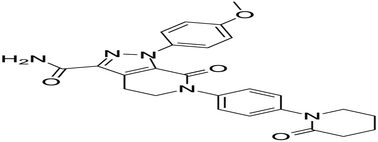Sensitive validated voltammetric determination of apixaban using a multi-walled carbon nanotube-modified carbon paste electrode: application to a drug product and biological sample†
Abstract
A sensitive, accurate and precise voltammetric method was developed and validated for the determination of a selective factor Xa inhibitor apixaban in drug substances using a multi-walled carbon nanotube-modified carbon paste electrode (MWCNT/CPE). The electrochemical behaviour of apixaban showed an irreversible diffusion-controlled oxidation process at a potential of 1.21 V in neutralized phthalate buffer (pH 5.0). Various experimental conditions were investigated and optimized including pH, different buffer type, different electrode modifier, scan rate and different surfactant type. The diffusion coefficient was calculated using the chronoamperometric technique. The peak current varied linearly over the concentration ranges from 1.99 × 10−6 mol L−1 to 1.07 × 10−4 mol L−1 with correlation coefficients of 0.9996. The detection and quantitation limits were 6.81 × 10−7 mol L−1 and 1.99 × 10−6 mol L−1, respectively. The method was successfully applied for the determination of apixaban in a drug product and spiked plasma with recoveries (%) ± RSD of 100.28 ± 1.30% and 100.64 ± 1.22% respectively. The results obtained were found to be in good agreement with those obtained with the reference method of the investigated drug. The validity of the method was assessed according to ICH guidelines.



 Please wait while we load your content...
Please wait while we load your content...